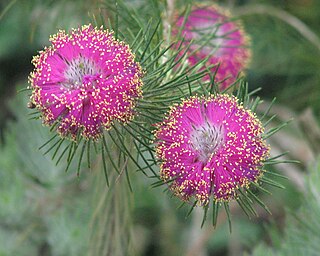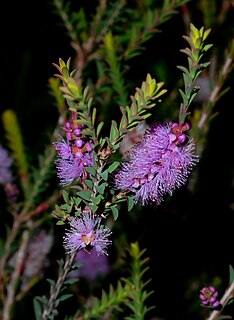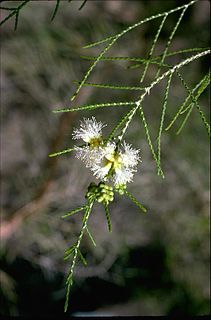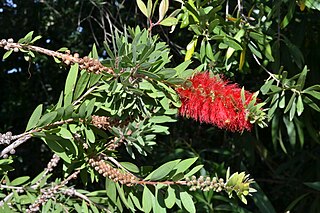
Melaleuca nesophila, commonly known as showy honey-myrtle, mindiyed or pink melaleuca, is a plant in the myrtle family, Myrtaceae and is endemic to an area near Albany in Western Australia. The Noongar name for the plant is mindiyet. Hardy and adaptable, with a dense crown of leaves and prolific heads of pink or purple flowers in late spring and summer, it is one of the most commonly cultivated melaleuca shrubs.

Melaleuca viminalis, commonly known as weeping bottlebrush, or creek bottlebrush is a plant in the myrtle family, Myrtaceae and is endemic to New South Wales, Queensland and Western Australia. It is a multi-trunked, large shrub or tree with hard bark, often pendulous foliage and large numbers of bright red bottlebrush flowers in spring and summer. It is possibly the most commonly cultivated melaleuca in gardens and its cultivars are often grown in many countries.

Melaleuca trichophylla is a shrub in the myrtle family, Myrtaceae, endemic to the south-west of Western Australia. Its pink or purple flowers appear from August to December in its native range. It has long been cultivated.

Melaleuca viridiflora, commonly known as broad-leaved paperbark is a plant in the myrtle family, Myrtaceae and is native to woodlands, swamps and streams of monsoonal areas of northern Australia and New Guinea. It is usually a small tree with an open canopy, papery bark and spikes of cream, yellow, green or red flowers.

Melaleuca elliptica, commonly known as the granite bottlebrush is a plant in the myrtle family, Myrtaceae and is endemic to the south of Western Australia. The Noongar name for the plant is gnow. It is commonly grown in gardens because of its neat foliage and showy, bright red flower spikes although it needs to be pruned regularly to avoid becoming woody and untidy-looking. In nature, it usually grows in the shrub layer in mallee woodland or heath.

Melaleuca phoenicea, commonly known as scarlet bottlebrush or lesser bottlebrush, is a plant in the myrtle family, Myrtaceae and is endemic to the south-west of Western Australia. The Noongar peoples know the plant as tubada. It is a shrub with thick, blue-green leaves and spikes of scarlet bottlebrush flowers in spring and summer.

Melaleuca pityoides, commonly known as alpine bottlebrush, is a plant in the family Myrtaceae, and is endemic to the higher areas of south eastern Australia. Some Australian state herbaria continue to use the name Callistemon pityoides. It is a shrub, often occurring in dense thickets, with hard bark, silvery-grey new growth, almost cylindrical leaves and spikes of flowers that are usually a shade of yellow.

Melaleuca ryeae is a plant in the myrtle family, Myrtaceae and is endemic to the south west of Western Australia. It is a small shrub, closely resembling Melaleuca amydra with its small leaves and profuse heads of pink to purple flowers but M.amydra has narrower leaves and does not have spherical clusters of fruits.

Melaleuca thymifolia, commonly known as thyme honey-myrtle, is a plant in the myrtle family Myrtaceae and is native to eastern Australia. It is often noticed in spring, with its attractive, purple flowers and is one of the most commonly cultivated melaleucas. A fragrant shrub, it usually grows to about 1.0 m (3 ft) tall, has corky bark and slender, wiry stems.

Melaleuca wilsonii, commonly known as Wilson's honey-myrtle or violet honey-myrtle, is a plant in the myrtle family, Myrtaceae, native to parts of South Australia and Victoria. It is a shrub with narrow, pointed leaves and heads of purplish-pink flowers on the sides of the branches. It is adaptable to a wide range of soils, frost hardy and often cultivated.

Melaleuca pulchella, commonly known as claw flower and claw honey-myrtle, is a plant in the myrtle family Myrtaceae, and is endemic to the south of Western Australia. It is one of only two species of Melaleuca to have two kinds of stamens. The outer stamens are longer and curved, giving the appearance of a claw to the flower. It is a hardy shrub flowering over a long period, and has been a popular garden plant for many years.

Melaleuca decussata, commonly known as cross-leaf honey-myrtle or totem poles, is a plant in the myrtle family, Myrtaceae native to South Australia and both native and naturalised in Victoria. It is an adaptable shrub, grown in many parts of Australia for its attractive foliage but is regarded as an environmental weed in parts of Victoria.

Melaleuca minutifolia, commonly known as teatree is a plant in the myrtle family, Myrtaceae and is endemic to northern Australia. As suggested by its name, it has tiny leaves but it also produces creamy white to white flowers throughout the year in its native range.

Melaleuca citrina, commonly known as common red bottlebrush, crimson bottlebrush, or lemon bottlebrush, is a plant in the myrtle family Myrtaceae, and is endemic to New South Wales and Victoria in Australia. Some Australian state herbaria continue to use the name Callistemon citrinus. Callistemon lanceolatus is an older name. It is a hardy and adaptable species, common in its natural habitat. It is widely cultivated, not only in Australia, often as a species of Callistemon. It was one of the first Australian plants to be grown outside the country, having been taken to England in 1770 by Joseph Banks. Its showy red flower spikes, present over most of the year in an ideal situation, account for its popularity.

Melaleuca pallida, commonly known as lemon bottlebrush, is a plant in the myrtle family, Myrtaceae and is endemic to eastern Australia. It is an upright shrub with thin, spreading branches, silvery new growth and pale yellow, sometimes pinkish bottlebrush flowers.

Melaleuca glomerata, commonly known as the desert honey-myrtle, inland paperbark or white tea-tree is a plant in the myrtle family Myrtaceae native to inland Australia. It is a small tree or shrub growing in arid areas, often in creek beds and shallow depressions.

Melaleuca diosmatifolia, commonly known as rosy paperbark and pink honey-myrtle is a plant in the myrtle family, Myrtaceae and is native to Queensland and New South Wales in Australia. It was formerly known as Melaleuca erubescens but is not closely related to Melaleuca diosmifolia although the species name has the same meaning. It has pointed, non-prickly leaves and cylindrical spikes of pink or purple flowers.

Melaleuca diosmifolia is a plant in the myrtle family, Myrtaceae and is endemic to the south-west of Western Australia. It has also become naturalised in Victoria (Australia) Australia. It is unusual for its genus in that the flowers are green, which partly accounts for its popularity as a garden plant. It is only distantly related to Melaleuca diosmatifolia although its species name has a similar etymology.
Melaleuca linophylla is a plant in the myrtle family Myrtaceae and is native to the north-west of Western Australia. It is a bushy shrub with narrow leaves and spikes of cream-coloured flowers in spring. It is distinguished by its fruits which are much more urn-shaped than those of other melaleucas.

Melaleuca microphylla is a plant in the myrtle family, Myrtaceae and is endemic to a small area in the south-west of Western Australia. It is a bushy shrub with small, crowded leaves and bears a close resemblance to the commonly cultivated Melaleuca ericifolia of the eastern states.





















